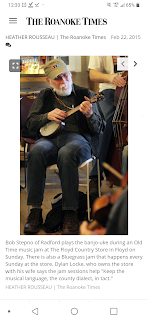Friday, August 07, 2015
Oldtime Country Music at archive.org
I'll come back and edit this, but wanted to put a few links out where new old-time music friends can find them today.
Sorry if there are spelling errors, and if you have to cut and paste the links into a browser. The first draft of this was done with my left thumb on a smartphone during a singing class at Augusta Heritage Center. (https://augustaheritagecenter.org)
Most of these are radio. Some are 1950s TV. The Delmore brothers sell their gospel song book, the Willis Brothers swing "Hillbilly Heaven." All Star Western Theatre combines accordion and guitar western harmonizing with short dramatic productions with cowboy movie stars of the forties. Pat Daniels Hillbilly Boys sold Hillbilly flour with Texas Swing, while Hank Williams sold Mother's Best flour with his country blues. Plenty here to explore.
https://archive.org/details/otr_countrymusictime
https://archive.org/details/OTRR_Delmore_Brothers_Singles
https://archive.org/details/OTRR_Certified_Delmore_Brothers
https://archive.org/details/GrandOldOpry-28april1956
https://archive.org/details/HankPennyHisRadioCowboys-01-10
https://archive.org/details/charlottecountry00holt Booklet PDF
https://archive.org/details/RanchParty1957
https://archive.org/details/0029OldTimeRadioReunion
https://archive.org/details/otr_countrymusictime
https://archive.org/details/OTRR_Mothers_Best_Flour_Singles
https://archive.org/details/OTRR_The_Hillbilly_Boys_Singles (Pat O'Daniel & the...), 74 episodes
https://archive.org/details/OTRR_All_Star_Western_Theatre_Singles
https://archive.org/details/otr_geneautry
https://archive.org/details/RoyRogers01-10
Tuesday, August 04, 2015
Some songs from Augusta
After singing along with these songs in Paul Brown's workshops at Davis & Elkins College's Augusta Heritage old-time music week, I compulsively went off looking for alternative versions, additional lyrics, and YouTube videos.
Cumberland Gap
https://youtu.be/t4Jawe-M2yc
Deadheads and suckers
https://youtu.be/N1byRXjV2LU
Tempy Roll Down Your Bangs
http://mudcat.org/thread.cfm?threadid=18014
Railroad Bill (with brakemans vest, nancy hanks verse)
http://pancocojams.blogspot.com/2013/09/riley-puckett-railroad-bill-information.html
Trouble in Mind
https://youtu.be/8a54Nz6aYYY
My home is across the blue ridge mountains
https://youtu.be/Z7i1CQv74aE
Walking in my sleep
https://youtu.be/LoRFJd47rtU
Poor Ellen Smith
murder case, Winston Salem c.1897
http://www.murderbygaslight.com/2010/07/poor-ellen-smith.html
http://mobile.nytimes.com/2009/02/02/us/02land.html?pagewanted=all&referrer=
Monday, April 27, 2015
It's a tiple
I finally made a short video of my other ukulele-family instrument, a 10-string "tiple." I'd like to think it was by popular request... usually phrased as "What the hell is that thing?"
The Martin guitar company made tiples for 30 years or more, using the same combinations of woods they used for guitars -- all mahogany models, or mahogany or rosewood tiples with spruce tops -- but I see no immediate threat of a revival in tiple playing... although something inspired the Ohana ukulele company to produce this version. In Colombia there is a larger instrument by the same name, with some marvelous players. YouTube will find you examples of both.
(Video oops... for some reason, when I talk about the tuning and play the four open notes, I say "from top to bottom" while picking the strings from bottom to top! Sorry if that confuses anyone. More on tuning below.)
They were also made by companies from Regal and Harmony to D'Angelico. I haven't retrieved a copy of Mike Longworth's Martin Guitar history recently, but the folks at Mandolin Brothers did -- when they had a tiple for sale some years ago -- and said, "The Martin Tiple, Longworth says, was designed around 1920 from a somewhat larger prototype imported from Argentina by Mr. William J. Smith who owned a New York City music company that bore his name." They also included more details about the specific model, a rosewood-and-spruce T-28.
For a couple of years while the bookmarking service "Delicious" was in regular operation, I saved almost 50 bookmarks to Web pages about the instrument (including parts of the blog http://martintiple.blogspot.com/) and YouTube videos of tiple players including the Spirits of Rhythm, the Cats & the Fiddle, Ed Askew, and more (at del.icio.us/bstepno/tiple) but the service has changed hands and has gone in and out of operation, while the internet archive preserved only a few of the links. So I have added a few more links below and will write other blog posts about interesting tiples now and then.
How "The Cats and the Fiddle" kept their instruments in tune with all the flipping and twirling in this movie clip amazes me. Perhaps Ohana needs to study 1930s Martins a bit more
https://youtu.be/SEQ9Sz0UCl8
The tuning is similar to a uke (or a guitar capoed at the fifth fret), but in four courses --
Gg-cCc-eEe-aa -- with the big letters indicating strings tuned an octave lower than the ones they are paired or tripled up with.
The second tune I play is one of my favorites, "I wish I could shimmy like my sister Kate," using a chord progression folks of a certain age will recognize as being pretty similar to Country Joe MacDonald's "Feel like I'm fixin' to die rag."
And a reissue of recordings by "Big Boy" Teddy Edwards, Chicago blues singer who recorded some solo tiple-accompanied vocals in the 1930s:
https://thedocumentrecordsstore.com/product/DOCD-5440/
Here's a sample of Edwards' style on YouTube: https://youtu.be/LL5_NE0cKec
Finally, here is the only classical piece of music I've heard orchestrated for an ensemble that includes a tiple: Gymnopédie No. 1 - Eric Satie, arranged and performed by Russick Smith for cello, double bass, mandolin, tiple, resonator guitar, and banjo: https://youtu.be/3rRU6Zs4kIw
Wednesday, February 25, 2015
Speaking the old-time language
It was the first Sunday that I'd made it to the jam in weeks of bad weather and/or bad timing. She caught me playing the Firefly banjo-ukulele I've already written about here.
Wednesday, January 28, 2015
In search of the mountain ukulele
My Firefly & Clawhammer Banjo-uke
First flights with Firefly banjo-uke
Update, August 2021:
This picture turned up in an oldtime radio discussion forum... I had no idea George Gobel started out as an adolescent radio-barn-dance ukulele player during his "Georgie" days! By the 1950s when I first saw him, he was much better known as Ernie Ford's "little bitty buddy" strumming orchestral jazz chords on an oversize Gibson Super 400 guitar along with the jokes and songs on TV.
That big Gibson was almost part of the joke itself, looking out of proportion strapped around the diminutive crewcut Goble. Result: Gibson even named a custom smaller, slimmer jazz guitar after him. (I haven't seen any archival clips showing him going back to the ukulele, but wouldn't be surprised if that didn't turn up in one of Gobel and Ford's TV comedy skits.)
But that's not all... Continued research (OK, a five-minute browse with Google) led to this fascinating claim about the ukulele as a way to dodge musicians' union dues:
"He was one of the favorites, as well as the youngest performer at the time on WLS' National Barn Dance, a homegrown program which was hugely popular from its inception in 1924 and enduring for over 50 years. George's era started with his debut in 1933. George played the ukulele, which was not a union instrument, thereby avoiding paying union dues."(Or maybe that was just a punchline in George's transition from mostly-musician to mostly-comedian?




